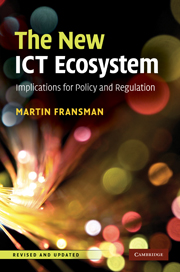Book contents
- Frontmatter
- Contents
- List of exhibits
- Preface
- List of abbreviations and acronyms
- Introduction
- 1 Summary of the argument
- 2 The new ICT ecosystem: architectural structure
- 3 The new ICT ecosystem as an innovation system
- 4 The new ICT ecosystem: a quantitative analysis
- 5 Telecoms regulation
- 6 Policy-making for the new ICT ecosystem
- 7 The way forward: the message to policy-makers and regulators
- Appendixes
- Bibliography
- Index
2 - The new ICT ecosystem: architectural structure
Published online by Cambridge University Press: 04 May 2010
- Frontmatter
- Contents
- List of exhibits
- Preface
- List of abbreviations and acronyms
- Introduction
- 1 Summary of the argument
- 2 The new ICT ecosystem: architectural structure
- 3 The new ICT ecosystem as an innovation system
- 4 The new ICT ecosystem: a quantitative analysis
- 5 Telecoms regulation
- 6 Policy-making for the new ICT ecosystem
- 7 The way forward: the message to policy-makers and regulators
- Appendixes
- Bibliography
- Index
Summary
In this chapter, we examine the architectural structure of the new ICT ecosystem using a layer model. In chapter 3 the innovation process in this system is analysed.
Introduction
We need to ask four key questions here:
What are the component parts of the new ICT ecosystem?
How do these parts interact with one another to form a coherent industrial system?
What are the main forces that drive the new ecosystem?
How has the system been affected by globalisation and the international division of labour?
We start by constructing a qualitative model that will provide an answer to all these kinds of questions.
The structure of the new ICT ecosystem: the ecosystem layer model (ELM)
Introduction
A Google search reveals how widespread is reference to ‘ICT’ and even to the ‘ICT sector’. However, such a search does not readily reveal (indeed hardly reveals at all) what is meant by the ‘ICT industry’. What is clear is that the letters I and C refer to information and communications, respectively, and that T refers to technology. Less clear is what we are meant to understand by the ICT sector, that is a sector of economic activity based on information and communication technologies: What are the component parts of this sector? How do these parts interact with one another? What are the forces that drive change within each of these parts? What drives ‘the system’ as a whole, consisting of all the interacting parts of the sector – that is, how does this sector work?
- Type
- Chapter
- Information
- The New ICT EcosystemImplications for Policy and Regulation, pp. 21 - 33Publisher: Cambridge University PressPrint publication year: 2010
- 1
- Cited by



